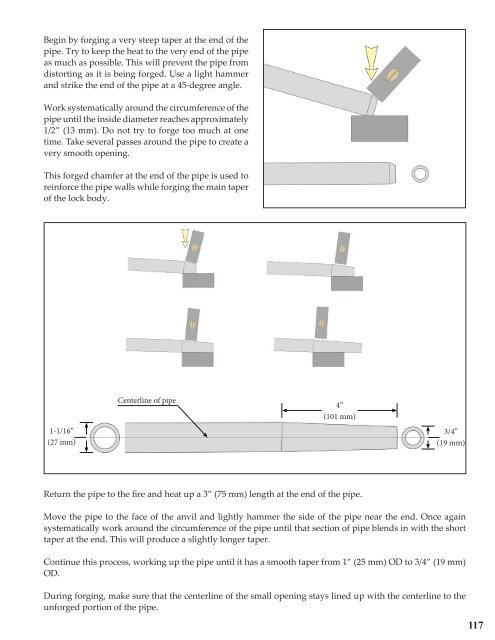The New Spruce Forge Manual of Locksmithing: A Blacksmith’s Guide to Simple Lock Mechanisms
The New Spruce Forge Manual of Locksmithing: a Blacksmith’s Guide to Simple Lock Mechanisms is a totally revised and expanded version of the original work from 1999. This new hardcover edition, at 304 pages and with more than 800 color photos and illustrations, is more than double the size of the original manual. It is divided into two distinct sections: Technical Information - This section is a reference manual in itself that covers the specific tools and techniques needed to build all the parts for each lock, as well as providing the information needed to understand the assembly instructions outlined in the second section. The Locks: Patterns & Instructions - This section provides the plans and detailed instructions for each of the 14 lock projects in this new edition. The clear assembly instructions describe when and how to use the technical information provided in section one. The authors have maintained their original trademark style that relies on well-illustrated step-by-step instructions that guide you through the whole lock-making process. They have also kept their low-tech approach that demonstrates how to go about creating good work using only a handful of simple tools. Making blacksmith locks is an age-old skill the authors of this manual are helping to preserve by passing on their knowledge to this book’s readers. The New Spruce Forge Manual of Locksmithing is also an excellent introduction to benchwork, which is a useful skill for any blacksmith to acquire. This manual will become a valuable, trusted and often referred to sourcebook in your blacksmithing library. Hardcover, 304 pages, more than 800 photos and illustrations.
The New Spruce Forge Manual of Locksmithing: a Blacksmith’s Guide to Simple Lock Mechanisms is a totally revised and expanded version of the original work from 1999. This new hardcover edition, at 304 pages and with more than 800 color photos and illustrations, is more than double the size of the original manual.
It is divided into two distinct sections:
Technical Information - This section is a reference manual in itself that covers the specific tools and techniques needed to build all the parts for each lock, as well as providing the information needed to understand the assembly instructions outlined in the second section.
The Locks: Patterns & Instructions - This section provides the plans and detailed instructions for each of the 14 lock projects in this new edition. The clear assembly instructions describe when and how to use the technical information provided in section one.
The authors have maintained their original trademark style that relies on well-illustrated step-by-step instructions that guide you through the whole lock-making process. They have also kept their low-tech approach that demonstrates how to go about creating good work using only a handful of simple tools.
Making blacksmith locks is an age-old skill the authors of this manual are helping to preserve by passing on their knowledge to this book’s readers. The New Spruce Forge Manual of Locksmithing is also an excellent introduction to benchwork, which is a useful skill for any blacksmith to acquire. This manual will become a valuable, trusted and often referred to sourcebook in your blacksmithing library.
Hardcover, 304 pages, more than 800 photos and illustrations.
You also want an ePaper? Increase the reach of your titles
YUMPU automatically turns print PDFs into web optimized ePapers that Google loves.
Begin by forging a very steep taper at the end <strong>of</strong> the<br />
pipe. Try <strong>to</strong> keep the heat <strong>to</strong> the very end <strong>of</strong> the pipe<br />
as much as possible. This will prevent the pipe from<br />
dis<strong>to</strong>rting as it is being forged. Use a light hammer<br />
and strike the end <strong>of</strong> the pipe at a 45-degree angle.<br />
Work systematically around the circumference <strong>of</strong> the<br />
pipe until the inside diameter reaches approximately<br />
1/2” (13 mm). Do not try <strong>to</strong> forge <strong>to</strong>o much at one<br />
time. Take several passes around the pipe <strong>to</strong> create a<br />
very smooth opening.<br />
This forged chamfer at the end <strong>of</strong> the pipe is used <strong>to</strong><br />
reinforce the pipe walls while forging the main taper<br />
<strong>of</strong> the lock body.<br />
1-1/16”<br />
(27 mm)<br />
Centerline <strong>of</strong> pipe<br />
4”<br />
(101 mm)<br />
3/4”<br />
(19 mm)<br />
Return the pipe <strong>to</strong> the fire and heat up a 3” (75 mm) length at the end <strong>of</strong> the pipe.<br />
Move the pipe <strong>to</strong> the face <strong>of</strong> the anvil and lightly hammer the side <strong>of</strong> the pipe near the end. Once again<br />
systematically work around the circumference <strong>of</strong> the pipe until that section <strong>of</strong> pipe blends in with the short<br />
taper at the end. This will produce a slightly longer taper.<br />
Continue this process, working up the pipe until it has a smooth taper from 1” (25 mm) OD <strong>to</strong> 3/4” (19 mm)<br />
OD.<br />
During forging, make sure that the centerline <strong>of</strong> the small opening stays lined up with the centerline <strong>to</strong> the<br />
unforged portion <strong>of</strong> the pipe.<br />
117










